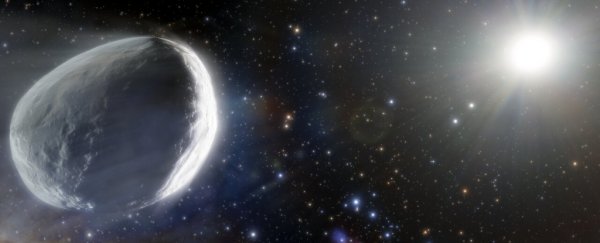A comet so huge it was initially mistaken for a dwarf planet is on an inward-bound trajectory from the outer Solar System.
There's no reason to worry – C/2014 UN271 (Bernardinelli-Bernstein), as the comet is called, will approach no closer to the Sun than just outside the orbit of Saturn. But its large size and relative closeness will afford a rare opportunity to study a pristine object from the Oort Cloud, and find new information about the formation of the Solar System.
"We have the privilege of having discovered perhaps the largest comet ever seen – or at least larger than any well-studied one – and caught it early enough for people to watch it evolve as it approaches and warms up," co-discoverer and astronomer Gary Bernstein from the University of Pennsylvania said earlier this year.
"It has not visited the Solar System in more than 3 million years."
The outer Solar System, by and large, is a somewhat mysterious place. It's very far away, and quite dark, and the objects in it quite small, so seeing what's out there past the orbit of Neptune is quite challenging.
We have a general idea of the architecture of that region of space, with the Kuiper Belt consisting of small icy bodies, and then the Oort Cloud at much greater distances, but the specifics are harder to drill down.
We're getting more information from an unexpected source, however: the Dark Energy Survey (DES), which ran between August 2013 and January 2019.
It pored over the southern sky in infrared and near-infrared for the course of several hundred nights, studying objects such as supernovae and galaxy clusters, to try to calculate the acceleration of expansion of the Universe, thought to be influenced by dark energy.
The depth, breadth, and precision of the survey turned out to be very good for identifying objects in the outer Solar System, too, beyond Neptune's orbit at around 30 astronomical units from the Sun. Earlier this year, a team of astronomers revealed that they had discovered 461 previously unknown objects in the outer Solar System in DES data.
One of those objects, spotted by Bernstein and fellow University of Pennsylvania astronomer Pedro Bernardinelli, was C/2014 UN271 (Bernardinelli-Bernstein). Now, they and their colleagues have described the comet in greater detail in a preprint paper accepted into The Astrophysical Journal Letters.
"We conclude that C/2014 UN271 (Bernardinelli-Bernstein) is a 'new' comet in the sense that there is no evidence for previous approach closer than 18 au to the Sun since ejection into the Oort Cloud," the researchers write.
"Indeed, this may be the most pristine comet ever observed, in that we have detected it before it comes within Uranus's orbit, and it may never have done so on any previous orbit."
According to the team's analysis, C/2014 UN271 (Bernardinelli-Bernstein) started its inward journey at a distance of around 40,400 astronomical units from the Sun. That's very much in Oort Cloud territory, a huge sphere of icy objects that extends anywhere from around 2,000 to as far as 100,000 astronomical units.
When it was discovered, the comet was at a distance of around 29 astronomical units from the Sun. Its closest approach to the Sun will occur in 2031, when it will reach a distance of 10.97 astronomical units; Saturn's orbit, for context, has an average distance of 9.5 astronomical units.
At a size of 155 kilometers (96 miles) in diameter, C/2014 UN271 (Bernardinelli-Bernstein) is an absolute chonker, but even so, will not be visible to the naked eye at that distance.
Scientists, however, will be taking every opportunity to study it using telescopes. They hope that learning more about its composition will be able to tell us more about the early Solar System, and its far reaches.
That's because icy rocks from the distant fringes of our planetary system are thought to be more or less unchanged since they formed, around 4.5 billion years ago. The volatiles locked up in the comet's ices should therefore contain information about the chemistry of the outer Solar System during its formation.
The scientists have already spotted signs of a coma, the cometary atmosphere that appears when a comet draws closer to the Sun. The increasing warmth sublimates ices on the comet's surfaces, producing the visible coma and, at closer distances, cometary tails. Spectral analysis of these features will tell us a lot about what's inside C/2014 UN271 (Bernardinelli-Bernstein).
Since we know very little about the Oort Cloud and the objects therein, C/2014 UN271 (Bernardinelli-Bernstein) represents a very rare window into this enigmatic region of our home in space.
The research has been accepted into The Astrophysical Journal Letters, and is available on arXiv.
